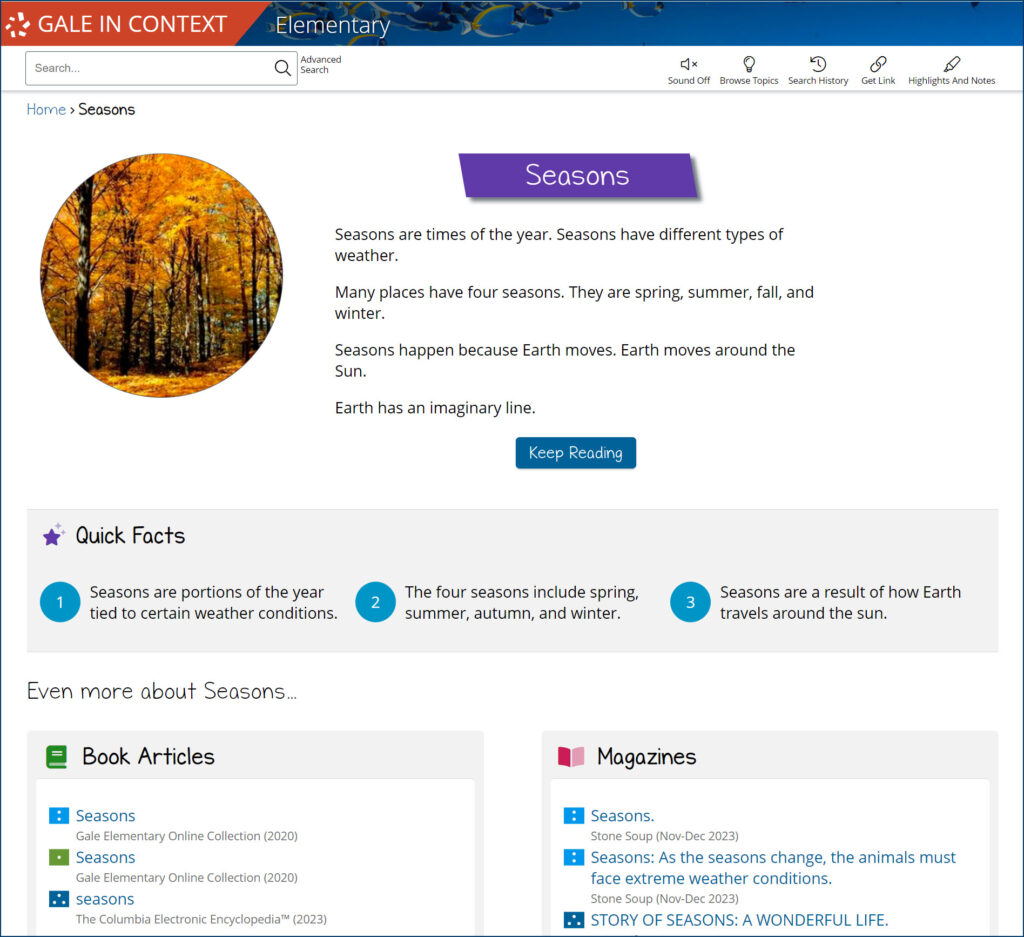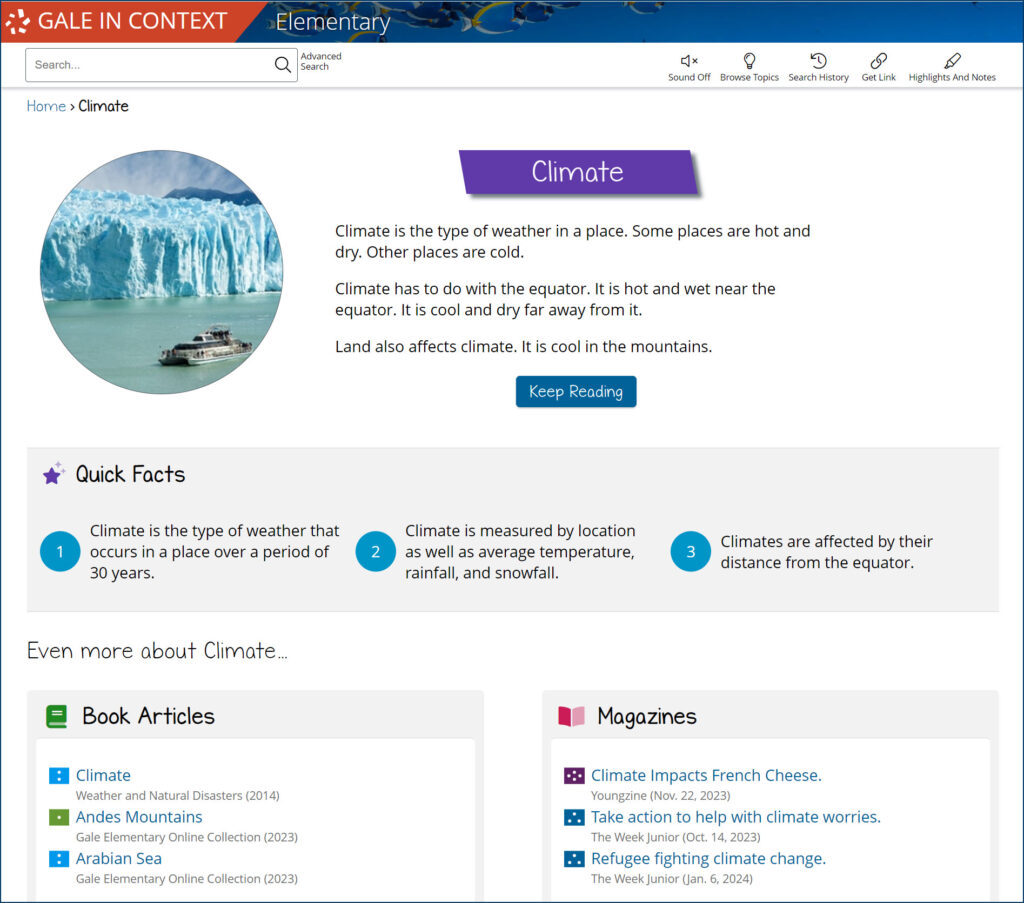| By Gale Staff |
From muggy, late summer days to crisp, Friday night football games, the changing seasons serve as a backdrop to the passage of our school year. Of course, stark seasonal changes vary depending on where you live, but with spring on the horizon, elementary school teachers can build seasonal topics into their lesson plans.
Packed with fascinating content, Gale In Context: Elementary can help your students reach new academic milestones and add some “spring” to their step. Gale developed this database in a kid-friendly, approachable format. We feature content through different presentation styles, leveraging an extensive library of images, vibrant colors, and playful fonts that catch young students’ attention. We also offer individualized support with adjustable text based on their reading level and built-in audio.
This year, the first day of spring is Tuesday, March 19. With Gale In Context: Elementary, it’s easy to find and integrate content on related subjects like weather, climate, and the changing seasons. These fun, engaging lesson plans will help your young students shake off the winter blues and prepare for a successful spring semester.
Study the Spring Equinox
The first day of spring is called the spring or vernal equinox. An equinox, a Latin word meaning “equal night,” describes the date sunlight directly hits the Earth’s equator, creating an equal amount of day and night. As we approach the beginning of spring, introduce this idea to your class and discuss how the Earth orbits the sun at an angle called the axial tilt. (You can check out this helpful video for visual learners!) Gale In Context: Elementary provides helpful context to understanding the why behind these seasonal changes and astronomical concepts.
The Northern Hemisphere begins to tilt toward the sun in December, and the increased sunlight slowly leads to changes in our environment. Foster your students’ observation skills. What do they notice as winter comes to a close? Longer daylight hours, melting snow, and warmer temperatures indicate spring is in the air. Have they noticed any flowers or animals returning after the cold winter months? Go outside! As a class, plan a nature walk (maybe at a nearby park) and bring your observation journals.
Activity Idea: Create colorful, spring-themed artwork to celebrate the changing seasons. Using a range of media (paints, markers, glitter, seeds—whatever you have in your classroom), let students express their own creative image of spring. You may have one student draw bright flowers, and another illustrate a baseball game. Students can share what springtime means to them and hang their art around the classroom.
Learn About Seeds—and Watch Them Grow
Some of the first clear signs of springtime are the flowers. The ground is thawing, and the sunlight warms the air, helping plants grow. Ask your students where these plants come from—the budding spring season is the perfect time to integrate a lesson about seeds into your science class. Seeds come in all shapes and sizes, and many lie dormant in the ground until the soil reaches the right temperature and provides enough moisture. As spring approaches, these little sleeping seeds wake up and have their moment to shine.
As a class, learn about a plant’s lifecycle, starting with the seed. Encourage students to reflect that a tiny seed encompasses the building blocks for a whole plant. Seeds may be small, but they’re vital; in addition to gardening, humans use seeds for medicine, food, and even jewelry. Have students use Gale in Context: Elementary to learn the different parts of a seed, what a seed requires to thrive, and how seeds move from place to place.
Activity Idea: Plant a seed. Using small pots (even a Dixie cup will do), students can scoop in soil and carefully plant a few seeds. Mark each cup with their name, and direct students to water (a spray bottle works well) and care for their little seed daily. Watch as the seeds sprout; have students write down their daily observations. Once they begin growing, you can even transplant them from the cup into a small garden outside your school or into larger plastic pots to take home.
Discuss Our Changing Climate
One of the main indications that spring is coming is the changing weather. Ask students why different places experience different weather patterns. Why is it warm in San Diego but snowing in Lake Tahoe? Weather can change abruptly from day to day. A region’s climate, however, is the standard weather pattern a region experiences over the long term. Certain climates experience more dramatic seasonal changes (New England, for example), whereas others expect mild adjustments from season to season.
Your students have likely heard about the threat of climate change, especially with their exposure to young activists on social media platforms. Rely on Gale’s unbiased and science-based tools to assist you in introducing the topic. As the Earth’s atmosphere changes due to greenhouse gases, regional climates also fluctuate. Impacts might be odd, such as unseasonably warm weather—but this can also include severe weather events with harmful consequences. Climate change affects how plants grow and can alter our food supply. Certain seasons may last longer, which impacts certain sports and activities. In extreme cases, climate change even forces some people to leave their homes.
Discussion Idea: Guide students to biographical information about some of today’s young climate activists. Have them research one such figure and share anything that stood out to them. For example, Greta Thunberg, who is just 21 years old, has inspired millions of young people to protest climate change (and has been twice nominated for the Nobel Peace Prize). Learning about these young figures introduces your students to positive role models fighting for these important causes.
Spring is the season to reinvigorate your classroom goals and finish the year strong. Gale In Context: Elementary will help you develop new lesson plans and inspire your students to be curious and ask important questions (saving you time as you look forward to some much-needed time off). Leverage Gale’s databases to celebrate the changing seasons and engage in the topics your students care about.
If your school is not a Gale subscriber, contact your local representative to learn more about our products.



